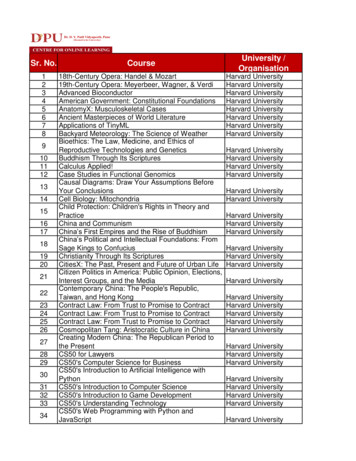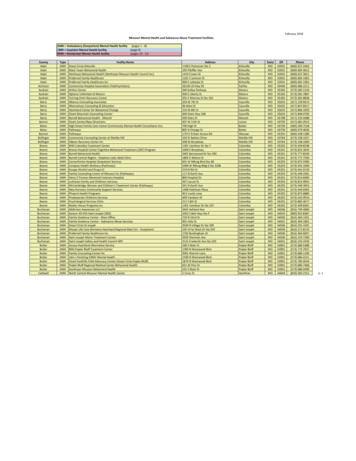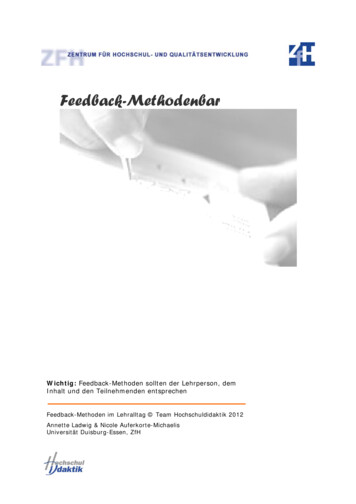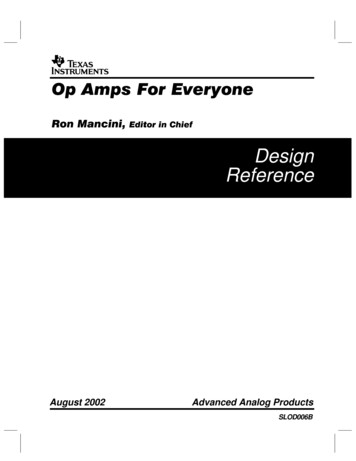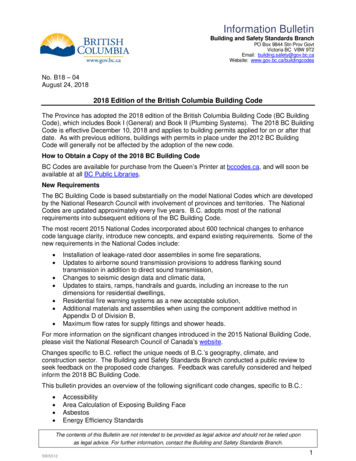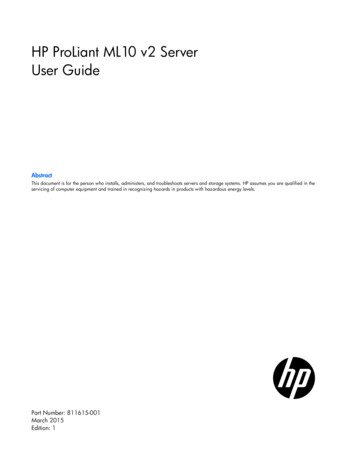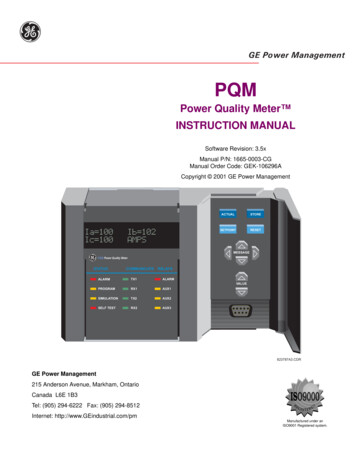
Transcription
Review of EducationalResearchMarch 2007, Vol. 77, No. 1, pp. 81-112DOI: 10.3102/003465430298487The Power of FeedbackJohn Hattie and Helen TimperleyUniversity of AucklandFeedback is one of the most powerful influences on learning and achievement, but this impact can be either positive or negative. Its power is frequently mentioned in articles about learningand teaching, but surprisinglyfew recent studies have systematically investigatedits meaning. This articleprovides a conceptualanalysis offeedback and reviews the evidence relatedto its impact on learningand achievement.This evidence shows thatalthoughfeedback is among the major influences, the type offeedback and the way itis given can be differentially effective. A model offeedback is then proposedthat identifiesthe particularpropertiesand circumstances thatmake it effective, and some typically thorny issues are discussed, including the timing offeedback and the effects ofpositive andnegativefeedback. Finally,this analysis is used to suggestways in whichfeedback can be used to enhance its effectiveness in classrooms.KEYWORDS: feedback, assessment, student and teacher learning.Although it is often mentioned in articles about learning and teaching, surprisingly few recent studies have systematically investigated the meaning of feedbackin classrooms. In this article, we begin with a conceptual analysis of the meaningof feedback and a synthesis of the evidence related to the power of feedback toimprove teaching and learning. We then propose a model of feedback that is usedto identify the circumstances under which feedback has the greatest impact.Specifically, the research evidence related to the different types of feedback andtheir effectiveness in terms of promoting student learning are discussed, the different ways students deal with feedback are described, and the relationshipbetween assessment and feedback is provided. Finally, the model, together withthe evidence underpinning it, is used to show how feedback can be used to enhanceclassroom learning and teaching.The Meaning of FeedbackIn this review, feedback is conceptualized as information provided by an agent(e.g., teacher, peer, book, parent, self, experience) regarding aspects of one's performance or understanding. A teacher or parent can provide corrective information, a peer can provide an alternative strategy, a book can provide information toclarify ideas, a parent can provide encouragement, and a learner can look up theanswer to evaluate the correctness of a response. Feedback thus is a "consequence"of performance.81
Hattie & TimperleyTo assist in understanding the purpose, effects, and types of feedback, it is useful to consider a continuum of instruction and feedback. At one end of the continuum is a clear distinction between providing instruction and providing feedback.However, when feedback is combined with more a correctional review, the feedback and instruction become intertwined until "the process itself takes on the formsof new instruction, rather than informing the student solely about correctness"(Kulhavy, 1977, p. 212). To take on this instructional purpose, feedback needs toprovide information specifically relating to the task or process of learning that fillsa gap between what is understood and what is aimed to be understood (Sadler,1989), and it can do this in a number of different ways. These may be through affective processes, such as increased effort, motivation, or engagement. Alternatively,the gap may be reduced through a number of different cognitive processes, including restructuring understandings, confirming to students that they are correct orincorrect, indicating that more information is available or needed, pointing to directions students could pursue, and/or indicating alternative strategies to understandparticular information. Winne and Butler (1994) provided an excellent summary intheir claim that "feedback is information with which a learner can confirm, add to,overwrite, tune, or restructure information in memory, whether that information isdomain knowledge, meta-cognitive knowledge, beliefs about self and tasks, or cognitive tactics and strategies" (p. 5740).Feedback has no effect in a vacuum; to be powerful in its effect, there must be alearning context to which feedback is addressed. It is but part of the teaching processand is that which happens second-after a student has responded to initial instruction-when information is provided regarding some aspect(s) of the student's taskperformance. It is mostpowerful when it addresses faulty interpretations, not a totallack of understanding. Under the latter circumstance, it may even be threatening toa student: "If the material studied is unfamiliar or abstruse, providing feedbackshould have little effect on criterion performance, since there is no way to relate thenew information to what is already known" (Kulhavy, 1977, p. 220).The focus of this article on feedback as information about the content and/orunderstanding of the constructions that students have made from the learning experience is not the same as a behaviorist input-output model. Contrary to the behaviorists' argument, Kulhavy (1977) demonstrated that feedback is not necessarily areinforcer, because feedback can be accepted, modified, or rejected. Feedback byitself may not have the power to initiate further action. In addition, it is the casethat feedback is not only given by teachers, students, peers, and so on, but can alsobe sought by students, peers, and so on, and detected by a learner without it beingintentionally sought.The Effectiveness of FeedbackThe first question to ask is, How effective is feedback? We answer this question by referring to the usual effects of schooling on student achievement and thencomparing them with the evidence related to feedback. Hattie (1999) reported asynthesis of over 500 meta-analyses, involving 450,000 effect sizes from 180,000studies, representing approximately 20 to 30 million students, on various influences on student achievement. This analysis included more than 100 factors influencing educational achievement and covered various aspects of those typically82
TABLE 1Summary of effect sizesfrom 12 meta-analysesassessing the influences offeedbackNumber ofeffectsEffectsize351.24Cues, corrective feedbackCues, motivationalinfluences, and reinforcementCues, participation,reinforcement, feedback,and correctives541.13190.81150.74Extrinsic feedback rewardsDiagnostic feedback inscience450.60490.524700.38From student ratingsFeedback280.340.29From testingImmediate versus delayed40530.280.28Rewards and punishmentsTeacher praise89140.14012StudyContextSkiba, Casey, andCenter (1985-1986)Lysakowski andWalberg (1982)Walberg (1982)For special educationstudentsTenenbaum andGoldring (1989)Rummel andFeinberg (1988)Yeany and Miller (1983)Kluger and DeNisi (1996)L'Hommedieu, Menges,and Brinko (1990)Moin (1986)Bangert-Drowns,Kulik, Kulik, andMorgan (1991)Kulik and Kulik (1988)Getsie, Langer, andGlass (1985)Wilkinson (1981)Feedbackidentified, such as attributes of schools, homes, students, teachers, and curricula.The average or typical effect of schooling was 0.40 (SE 0.05), and this provideda benchmark figure or "standard" from which to judge the various influences onachievement, such as that of feedback.At least 12 previous meta-analyses have included specific information on feedbackin classrooms (Table 1). These meta-analyses included 196 studies and 6,972effect sizes. The average effect size was 0.79 (twice the average effect). To placethis average of 0.79 into perspective, it fell in the top 5 to 10 highest influences onachievement in Hattie's (1999) synthesis, along with direct instruction (0.93), reciprocal teaching (0.86), students' prior cognitive ability (0.71), and also can be contrasted with other influences such as acceleration (0.47), socioeconomic influences(0.44), homework (0.41), the use of calculators (0.24), reducing class size (0.12),and retention back 1 year (-0.12). Clearly, feedback can be powerful.The effect sizes reported in the feedback meta-analyses, however, show considerable variability, indicating that some types of feedback are more powerful83
TABLE 2Summary of effect sizes relatingtofeedback effectsVariableCuesFeedbackReinforcementVideo or audio feedbackComputer-assistedinstructional feedbackGoals and feedbackStudent evaluation feedbackCorrective feedbackDelayed versus immediateRewardImmediate versus delayedPunishmentPraiseProgrammed instructionNumber ofmeta-analysesNumber ofstudiesNumber 370.340.310.240.200.14-0.04than others. Those studies showing the highest effect sizes involved studentsreceiving information feedback about a task and how to do it more effectively.Lower effect sizes were related to praise, rewards, and punishment.A more detailed synthesis of 74 meta-analyses in Hattie's (1999) database thatincluded some information about feedback (across more than 7,000 studies and13,370 effect sizes, including those in Table 2) demonstrated that the most effective forms of feedback provide cues or reinforcement to learners; are in the formof video-, audio-, or computer-assisted instructional feedback; and/or relate togoals. Programmed instruction, praise, punishment, and extrinsic rewards were theleast effective for enhancing achievement (Table 3). Indeed, it is doubtful whetherrewards should be thought of as feedback at all. Deci, Koestner, and Ryan (1999)described tangible rewards (stickers, awards, etc.) as contingencies to activitiesrather than feedback because they contain such little task information. In theirmeta-analysis of the effects of feedback on motivation, these authors found a negative correlation between extrinsic rewards and task performance (-0.34). Tangiblerewards significantly undermined intrinsic motivation, particularly for interestingtasks (-0.68) compared with uninteresting tasks (0.18). In addition, when the feedback was administered in a controlling manner (e.g., saying that students performed as they "should" have performed), the effects were even worse (-0.78).Thus, Deci et al. concluded that extrinsic rewards are typically negative becausethey "undermine people's taking responsibility for motivating or regulating themselves" (p. 659). Rather, they are a controlling strategy that often leads to greatersurveillance, evaluation, and competition, all of which have been found to undermine enhanced engagement and regulation (Deci & Ryan, 1985).The most systematic study addressing the effects of various types of feedback wasconducted by Kluger and DeNisi (1996). Their meta-analysis included studies of84
TABLE 3Summary of effect sizes relatingto types offeedbackModeratorCorrect feedback'Tis correct'Tis incorrectTask feedback about changes fromprevious trialsYesNoTask feedback designed toNumber of effectsEffect 0.090.34873370.410.23discourage the studentYesNoPraise feedback about the taskYesNoFeedback provided from a computerYesNoNumber of times feedback wasprovided970.32LittleTask complexityVery complex1710.391070.03Not complexGoal settingDifficult goalsEasy, do your best goalsThreat to self-esteemMuch threat1140.55373730.510.301020.081700.47LotsLittle threatSource. Kiuger and DeNisi (1996).feedback interventions that were not confounded with other manipulations, includedat least a control group, measured performance, and included at least 10 participants.Many of their studies were not classroom based. From the 131 studies, they estimated470 effect sizes on the basis of 12,652 participants and 23,663 observations (reflecting multiple observations per participant). The average effect size was 0.38 (SE 0.09), and 32% of the effects were negative (Table 3). Over all comparisons, itappears that the power of feedback is influenced by the direction of the feedback relative to performance on a task. Specifically, feedback is more effective when it provides information on correct rather than incorrect responses and when it builds onchanges from previous trails. Theimpact of feedback was also influenced by the difficulty of goals and tasks. It appears to have the most impact when goals are specific85
Hattie & Timperleyand challenging but task complexity is low. Praise for task performance appears tobe ineffective, which is hardly surprising because it contains such little learningrelated information. It appears to be more effective when there are perceived lowrather than high levels of threat to self-esteem, presumably because low-threat conditions allow attention to be paid to the feedback.Given these mixed effects of feedback, we devote the remainder of this articleto identifying the conditions that maximize the positive effects on learning. Amodel of feedback is used as a framework to understand why particular kinds offeedback promote learning effectively and why some others do not.A Model of Feedbackin which feedback can be considered. The claimaframeworkpresentsFigure Iis made that the main purpose of feedback is to reduce discrepancies between current understandings and performance and a goal. Strategies students and teachersuse to reduce this discrepancy may be more or less effective in enhancing learning, so it is important to understand the circumstances that result in the differentialoutcomes. Effective feedback must answer three major questions asked by ateacher and/or by a student: Where am I going? (What are the goals?), How am Igoing? (What progress is being made toward the goal?), and Where to next? (Whatactivities need to be undertaken to make better progress?) These questions correspond to notions of feed up, feed back, and feed forward. How effectively answersto these questions serve to reduce the gap is partly dependent on the level at whichthe feedback operates. These include the level of task performance, the level ofprocess of understanding how to do a task, the regulatory or metacognitive processlevel, and/or the self or personal level (unrelated to the specifics of the task).Feedback has differing effects across these levels.A key theme arising from this review of the literature is the importance of ensuring that feedback is targeted at students at the appropriate level, because some feedback is effective in reducing the discrepancy between current understandings andwhat is desired, and some is ineffective. These issues are explored in greater depthas each aspect of the model is further explored.How Feedback Works: Reducing the Discrepancy Between Current andDesired UnderstandingThere are many possible ways for students to reduce the gap between currentand desired understandings in response to feedback, and they are not always effective in enhancing learning. Those likely to be effective include the following.Students can increase their effort, particularly when the effort leads to tacklingmore challenging tasks or appreciating higher quality experiences rather than justdoing "more." We are more likely to increase effort when the intended goal "isclear, when high commitment is secured for it, and when belief in eventual successis high" (Kluger & DeNisi, 1996, p. 260). Students may also develop effectiveerror detection skills, which lead to their own self-feedback aimed at reaching agoal. Such error detection can be very powerful, provided students have some modicum of knowledge and understanding about the task on which to strategize andregulate. In addition, students can seek better strategies to complete the task or betaught them, or they can obtain more information from which they can then solveproblems or use their self-regulatory proficiencies.86
PurposeTo reduce discrepancies between current understandings/performrance and a desired goalThe discrepancy can be reduced by.StudentsIncreased effort and employment of more effec ilvstrategies ORAbandoning, bluffng, or lowering the goalsTeachers* Providing appropriate challenging and specIf.,goalsAssisting students to reach ther thrrugh effective learning strategies and feedbackSEffective feedback answers three questionsWhereamgong?(theogoals)Feed UpHowI oJg?gmFeed BackWhere to nert?Feed ForwardEach feedback question works at four levels:Task levelProcess levelSelf-regulation levelSelf levelHow wel tasks areunderstood/performedThe mran process neededto understand/performtasksSelf-monlWrng,direclIng, andregulating of actionsPersonal evaluagions andeffect (usually pos tle)about the learnerFIGURE 1. A model offeedback to enhance learning.Some strategies to reduce the gap are less productive. Students may abandongoals and thus eliminate any gap, and this often leads to nonengagement in the pursuit of further goals (Bandura, 1982; Mikulincer, 1988; Steinberg, 1996). Theymay choose to blur the goals, combining them with so many others that after performing, they can pick and choose those goals they attained and ignore the others.Alternatively, students can change the standard by setting less challenging goals,accepting performance far below their capabilities as satisfactory.There are also multiple ways teachers can assist in reducing the gap betweenactual performance and desired goal attainment. These include providing appropriate challenging and specific goals. Specific goals are more effective than general or nonspecific ones, primarily because they focus students' attention, andfeedback can be more directed (Locke & Latham, 1984). The goals and associatedfeedback are also more likely to include information about the criteria for successin attaining them than more general goals.Teachers can also assist by clarifying goals, enhancing commitment orincreased effort to reaching them through feedback. Goals can also be made moremanageable by narrowing the range of reasonable hypotheses (Sweller, 1990).More generally, teachers can create a learning environment in which studentsdevelop self-regulation and error detection skills (Hattie, Biggs, & Purdie, 1996).How feedback contributes to these processes depends largely on the focus offeedback and the level to which it is directed. In the next section, we develop aframework to assist in identifying the circumstances likely to result in the moreproductive outcomes.87
Addressing the Three Feedback QuestionsEffective teaching not only involves imparting information and understandingsto students (or providing constructive tasks, environments, and learning) but alsoinvolves assessing and evaluating students' understanding of this information, sothat the next teaching act can be matched to the present understanding of the students. This "second part" is the feedback part, and it relates to the three major questions identified in Figure 1: Where am I going? How am I going? and Where tonext? These three questions address the dimensions of feed up, feed back, and feedforward. An ideal learning environment or experience occurs when both teachersand students seek answers to each of these questions. Too often, teachers limit students' opportunities to receive information about their performance in relation toany of these questions by assuming that responsibility for the students and not considering the learning possibilities for themselves.Where Am I Going?A critical aspect of feedback is the information given to students and their teachers about the attainment of learning goals related to the task or performance. Thesegoals can be wide ranging and include items such as singing a song, running a race,noting beauty in a painting, sanding a piece of wood, or riding a bicycle. Judgingthe success of goal attainment may occur on many dimensions. The judgments maybe direct, such as "passing a test" or "completing an assignment"; comparative,such as "doing better than Mary" or "doing better than last time"; social, such as"not getting a detention" or "seeking teacher approval"; engagement related, suchas "singing a song" or "running a race"; or automatic and triggered outside of specific awareness, such as "doing well on a task" or "seeking more challengingtasks." On this last type, Bargh, Gollwitzer, Lee-Chai, Barndollar, and Trotschel(2001) demonstrated that goals can promote goal-directed action (e.g., achievement or cooperation on tasks), produce persistence at task performance in the faceof obstacles, and favor the resumption of disrupted tasks even in the presence ofmore attractive alternatives. As Black and Wiliam (1998) concluded, "the provision of challenging assignments and extensive feedback lead to greater studentengagement and higher achievement" (p. 13)Goals may relate to specific attainments or understandings or to differing qualities of experience, and they typically involve two dimensions: challenge and commitment. Challenging goals relate to feedback in two major ways. First, theyinform individualsas to what type or level of performance is to be attained so that they can directand evaluate their actions and efforts accordingly. Feedback allows them toset reasonable goals and to track their performance in relation to their goalsso that adjustments in effort, direction, and even strategy can be made asneeded. (Locke & Latham, 1990, p. 23)These levels of attainment we have termed "success criteria," and goals withoutclarity as to when and how a student (and teacher) would know they were successful are often too vague to serve the purpose of enhancing learning. Second, feedback allows students (and/or their teachers) to set further appropriately challenging88
The Powerof Feedbackgoals as the previous ones are attained, thus establishing the conditions for ongoinglearning.The relationship between feedback and goal-related challenge is complex. Iffeedback does not lead to reducing the discrepancy between current understandings and goals, students are likely to close the gap by overstating their current status or claiming various attributions that reduce effort and engagement. Feedbackcannot lead to a reduction in this discrepancy if the goal is poorly defined, becausethe gap between current learning and intended learning is unlikely to be sufficientlyclear for students to see a need to reduce it (Earley, Northcraft, Lee, & Lituchy,1990; Erez, 1977; Frost & Mahoney, 1976). An additional problem occurs whenfeedback is not directed toward the attainment of a goal. Too often, the feedbackgiven is unrelated to achieving success on critical dimensions of the goal. Forexample, students are given feedback on presentation, spelling, and quantity inwriting when the criteria for success require, say, "creating mood in a story." Suchfeedback is not effective in reducing the gap relating to the intention of creatingmood (Clarke, Timperley, & Hattie, 2003; Timperley & Parr, 2005).When goalshave appropriate challenge and teachers and students are committed to these goals,a clearer understanding of the criteria for success is likely to be shared.Goals are more effective when students share a commitment to attaining them,because they are more likely to seek and receive feedback (Locke & Latham,1990). Teachers and parents often assume that students share a commitment to academic goals, whereas the reality is that developing this shared commitment needsto be nurtured and built. Commitment can be induced by authority figures; peergroups; competition; role models; public statements about intentions, incentives,and rewards; punishment; and general valence and instrumentality (e.g., Bandura,1986; Carroll, Houghton, Durkin, & Hattie, 2001; Hollenbeck, Klein, O'Leary, &Wright, 1989; Latham & Lee, 1986; Lee, Locke, & Latham, 1989; Locke &Latham, 1984). For example, Earley and Kanfer (1985) showed that modeling canbe effective by having participants watch a film of either a high-performing student or a low-performing student completing a class-scheduling task. Followingthis, students were assigned or encouraged to set difficult goals. Those who hadobserved the high-performing student in the video had significantly higher commitment levels than those who had observed the low-performing role model.How Am I Going?Answering this question involves a teacher (or peer, task, or self) providinginformation relative to a task or performance goal, often in relation to someexpected standard, to prior performance, and/or to success or failure on a specific part of the task. This aspect of feedback could be termed the feed-backdimension. Feedback is effective when it consists of information about progress,and/or about how to proceed. Students often seek information about "how theyare going," although they may not always welcome the answers. Too often, attention to this question leads to assessment or testing, whereas this is not the fundamental conception underlying this question. "Tests" are but one method usedby teachers and students to address this question and, as discussed below, oftenfail to convey feedback information that helps teachers and their students toknow how they are going.89
Where to Next?Instruction often is sequential, with teachers providing information, tasks, orlearning intentions; students attempting tasks; and some subsequent consequence.Too often, the consequence is more information, more tasks, and more expectations;students thus learn that the answer to "Where to next?" is "more." The power offeedback, however, can be used to specifically address this question by providinginformation that leads to greater possibilities for learning. These may includeenhanced challenges, more self-regulation over the learning process, greater fluencyand automaticity, more strategies and processes to work on the tasks, deeper understanding, and more information about what is and what is not understood. This feedforward question can have some of the most powerful impacts on learning.Integratingthe Three QuestionsRather than the above three questions working in isolation at each of the fourlevels, they typically work together. Feedback relating to "How am I going?" hasthe power to lead to undertaking further tasks or "Where to next?" relative to a goal"Where am I going?" As Sadler (1989) convincingly argued, it is closing the gapbetween where students are and where they are aiming to be that leads to the powerof feedback.The Focus of Feedback: The Four LevelsThe focus of feedback is critically important, and in this article, we claim thatthere are four major levels and that the level at which feedback is directed influences its effectiveness. First, feedback can be about a task or product, such aswhether work is correct or incorrect. This level of feedback may include directionsto acquire more, different, or correct information, such as "You need to includemore about the Treaty of Versailles." Second, feedback can be aimed at the processused to create a product or complete a task. This kind of feedback is more directlyaimed at the processing of information, or learning processes requiring understanding or completing the task. For example, a teacher or peer may say to alearner, "You need to edit this piece of writing by attending to the descriptors youhave used so the reader is able to understand the nuances of your meaning," or"This page may make more sense if you use the strategies we talked about earlier."Third, feedback to students can be focused at the self-regulation level, includinggreater skill in self-evaluation or confidence to engage further on a task. For example, "You already know the key features of the opening of an argument. Check tosee whether you have incorporated them in your first paragraph." Such feedbackcan have major influences on self-efficacy, self-regulatory proficiencies, and selfbeliefs about students as learners, such that the students are encouraged orinformed how to better and more effortlessly continue on the task. Fourth, feedback can be personal in the sense that it is directed to the "self," which, we arguebelow, is too often unrelated to performance on the task. Examples of such feedback include "You are a great student" and '"That's an intelligent response, welldone."Thus, there is a distinction between feedback about the task (FT), about the processing of the task (FP), about self-regulation (FR), and about the self as a person(FS). We argue that FS is the least effective, FR and FP are powerful in terms of90
The Power of Feedbackdeep processing and mastery of tasks, and FT is powerful when the task information subsequently is useful for improving strategy processing or enhancing selfregulation (which it too rarely does).FeedbackAbout the TaskThis level includes feedback about how well a task is being accomplished orperformed, such as distinguishing correct from incorrect answers, acquiring moreor different information, and building more surface knowledge. This type of feedback is most common and is often called corrective feedback or knowledge ofresults, and it can relate to correctness, neatness, behavior, or some other criterionrelated to task accomplishment; About 90% of teachers' questions (sometimeswritten but typically verbal) in classrooms are aimed at this information level(Airasian, 1997). Teachers commonly mix corrective feedback with informationat the self level, which dilutes the power of the FT (e.g., "Good boy, that is correct"; see Bennett & Kell, 1989). By itself, corrective feedback can be powerful.From various meta-analyses, Lysakowski and Walberg (1982) reported an effectsize of 1.13, Walberg (1982) reported 0.82, and Tenenbaum and Goldring (1989)reported 0.74, all of which are substantial effects. Having correct information is apedestal on which the processing and self-regulation is effectively built.FT is more powerful when it is about faulty interpretations, not lack of information. If students lack necessary knowledge, further instruction is more powerful than feedback information. One of the problems with feedback at the ta
45 0.60 49 0.52 470 From student ratings Feedback From testing Immediate versus delayed Rewards and punishments Teacher praise 0.38 28 0.34 0.29 40 0.28 53 0.28 89 0.14 14 012 identified, such as attributes of schools, homes, students, teachers, and curricula. The average or typical ef


